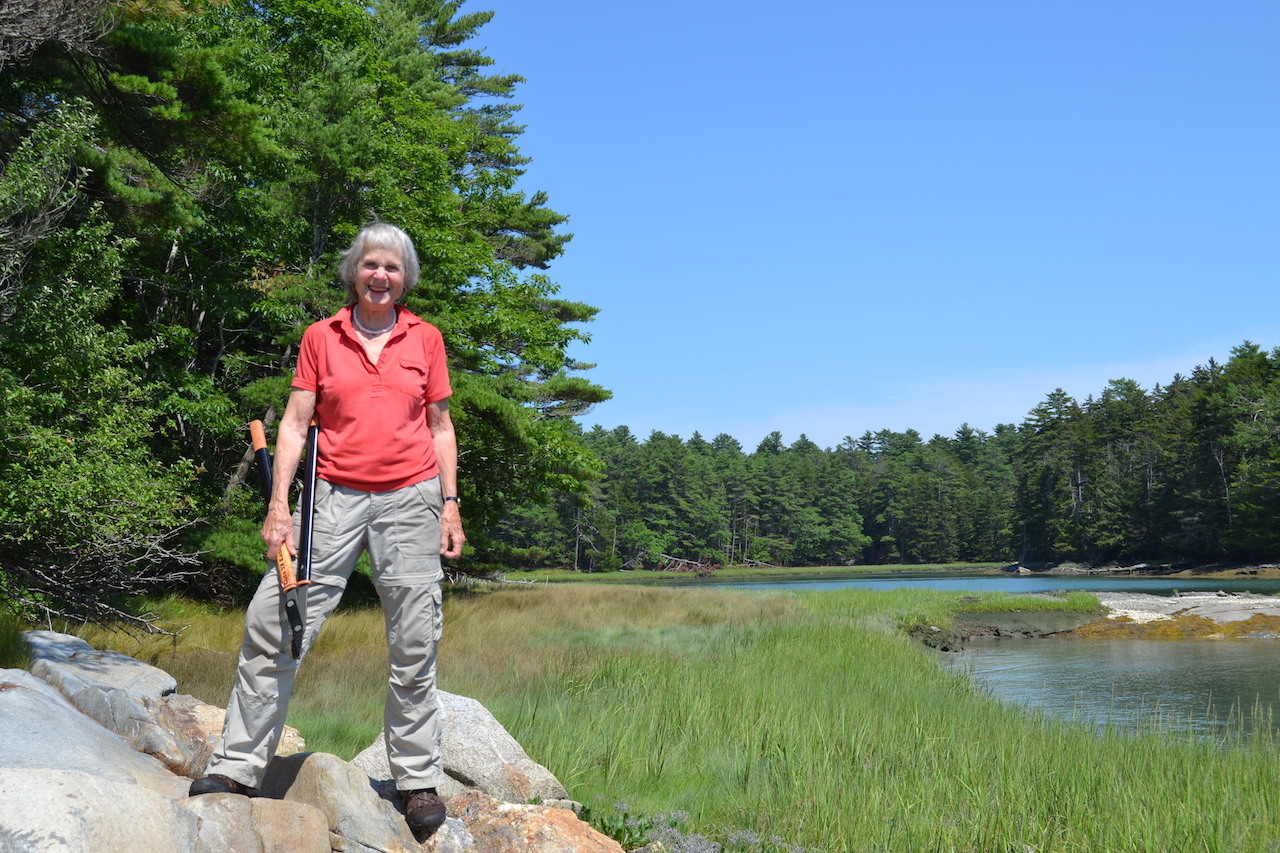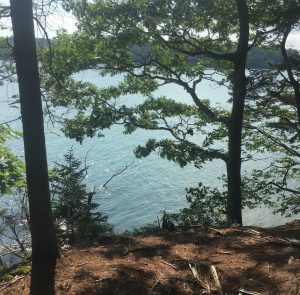
A walk to the water’s edge at the Darling Marine Center
By Hanna Deon
The trees along the Coveside Trail offer a shady refuge from the midday heat. Pine needles and fallen leaves crunch beneath my flip flops as I make my way through the woods, glancing out at Lowes Cove to find a perfect spot to sit by the water’s edge. White bell-like flowers and black-eyed Susans grow among the saplings. Overhead, chipmunks chatter and race up and down the branches. A visitor could devote hours to noticing the beauty of the woods along the cove, but today I was on a mission: to find the perfect sitting rock.
The well-worn path might make anyone believe that the Coveside Trail has always been part of the property, but in fact the trail is barely older than the undergraduate students who study here.
Ira C. Darling gifted his estate to the University of Maine in 1965, thereby establishing the Darling Marine Center. As the years passed, scientists and students took full advantage of the new marine lab, performing coastal and ocean ecology research, gaining field experience and taking marine science classes at the edge of the Damariscotta River estuary. By the 1970s, the DMC had built its pier, flowing seawater labs, cabins and classrooms. However, there were no walking trails, just a remnant of an unused path on the northern side of the property.
The summer of 1996 was the second time Elsie Morse stayed at the University of Maine’s Darling Marine Center. She was visiting from Providence, Rhode Island, with her husband, Doug Morse, a faculty member at Brown University and visiting researcher at the DMC. While he studied terrestrial ecology in the field between the upper and lower campus, Elsie explored nearby nature preserves.
Those walks inspired her to create trails on the DMC property. She asked then-director, Kevin Eckelbarger, if she could create some foot paths and began her work the very next day. She admitted that she knew absolutely nothing about trail-making when she first started, but a trailblazer only needs a good sense of direction and the ability to move fallen branches and trees out of the way.
Her first trailblazing mission was to create a path from the upper campus to Lowes Cove. Without trail tape or GPS mapping to mark a path, Elsie headed downhill in a southwesterly direction, occasionally marking her way with branches. When she arrived at the water’s edge, she realized she was exactly where she had hoped to be. The rest of the summer, Elsie worked to complete the Coveside trail.
“I think my favorite memory is the thrill of finding the cove on that first day,” Elsie recalls. “In truth, developing any trail is wonderful fun, and seeing the trails being enjoyed by visitors gives me great joy.”

The following summer Elsie cleared, widened, and extended the forgotten trail. Now named the River Bluff Trail, it follows the river’s edge and passes new scenic spots such as Silkie Beach, which is revealed at low tide, and Troll’s Picnic Point.
One by one, trails were added as new ideas or spots of interest emerged. As more people learned of Elsie’s ongoing project, her friends, neighbors, UMaine students and DMC faculty also helped clear up the trails from time to time.
Now, thanks to her twenty-two years of trail care and adventurous exploration, Elsie’s first Coveside Trail is part of a 3.5 mile network of nature trails and walking paths at the Darling Marine Center. The trails are open to the public year-round and allow easy explorations of the nearby forests, fields and river’s edge.
All the trails have unique stories. The Osprey Lookout Trail was created when Elsie was eager for her then 90-year old mother to see the osprey’s nest on the opposite shore of the cove. Elsie realized that the trails weren’t quite suitable for her mother’s all-terrain wheelchair, so the veteran trailblazer found a new route that would be more accessible.
Elsie’s intent was that anyone and everyone would be able to enjoy the trails, from the DMC faculty to the students to the public. Even now she walks the trails daily, which are more frequented by visitors.
“We have a real treasure in the DMC trails,” said Darling Marine Center director Heather Leslie. “With her deep passion for natural history and education, Elsie has been a real inspiration to me, as I’ve learned about the natural and human history of the property. I’m always delighted when my friends and neighbors discover the trails for themselves.”
Exploration of the trail system is highly encouraged. Trail maps can be found in the Visitor’s station, the trail kiosks, or online at dmc.umaine.edu/walking-trails. The DMC requests visitors to sign the guest book in the Horse Barn lobby. When walking on trails, always wear appropriate footwear and clothing for walking on uneven surfaces, be vigilant for ticks or poison ivy and please keep dogs leashed.
Contact: Hanna Deon, hanna.deon@maine.edu.
